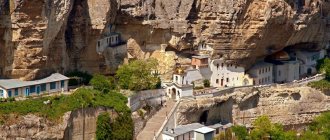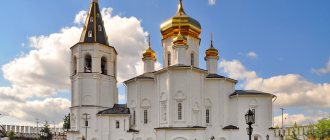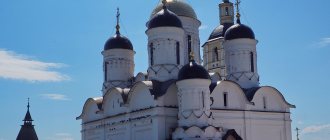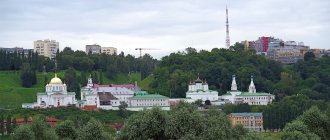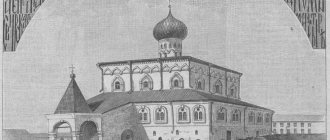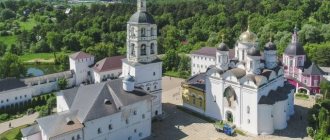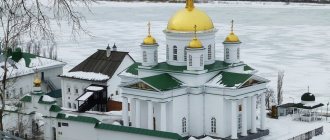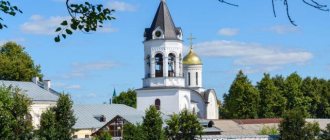Mir
Ukraine Kharkov region Kharkov Holy Protection Kharkov Monastery Map is loading…
{"format":"leaflet","minzoom":false,"maxzoom":false,"limit":50,"offset":0,"link":"all","sort":[""], "order":[],"headers":"show","mainlabel":"","intro":"","outro":"","searchlabel":"\u2026 \u0441\u043b\u0435\ u0434\u0443\u044e\u0449\u0438\u0435 \u0440\u0435\u0437\u0443\u043b\u044c\u0442\u0430\u0442\u044b","default":"","import-annotation":false,"width ":"auto","height":"350px","centre":{"text":"","title":"""link":"""lat":49.99171599999999671126715838909149169921875,"lon": 36.22881300000000237560016103088855743408203125,"icon":""},"title":"","label":"","icon":"","lines":[],"polygons":[], "circles":[ ],"rectangles":[],"copycoords":false,"static":false,"zoom":8,"defzoom":14,"layers":["OpenStreetMap"],"image layers":[] ,"overlays":[],"resizable":false,"fullscreen":true,"scrollwheelzoom":true,"cluster":false,"clustermaxzoom":9,"clusterzoomonclick":true,"clustermaxradius":80, "clusterspiderfy":true,"geojson":"","clicktarget":"","showtitle":true,"hidenamespace":false,"template":"","userparam":"","activeicon": "","pagelabel":false,"ajaxcoordproperty":"","ajaxquery":"","locations":[{"text":"\u003Cb\u003E\u003Ca href=\"/palomnik/%D0% A1%D0%B2%D1%8F%D1%82%D0%BE-%D0%9F%D0%BE%D0%BA%D1%80%D0%BE%D0%B2%D1%81%D0%BA %D0%B8%D0%B9_%D0%A5%D0%B0%D1%80%D1%8C%D0%BA%D0%BE%D0%B2%D1%81%D0%BA%D0%B8%D0 %B9_%D0%BC%D1%83%D0%B6%D1%81%D0%BA%D0%BE%D0%B9_%D0%BC%D0%BE%D0%BD%D0%B0%D1%81 %D1%82%D1%8B%D1%80%D1%8C\" title=\"\u0421\u0432\u044f\u0442\u043e-\u041f\u043e\u043a\u0440\u043e\u0432\u0441\u043a\ u0438\u0439 \u0425\u0430\u0440\u044c\u043a\u043e\u0432\u0441\u043a\u0438\u0439 \u043c\u0443\u0436\u0441\u043a\u043e\u0439 \u 043c\u043e\u043d\u0430\u0441\ u0442\u044b\u0440\u044c\»\u003E\u0421\u0432\u044f\u0442\u043e-\u041f\u043e\u043a\u0440\u043e\u0432\u0441\u043a\u0438\u0439\ u0425\u0430\u0440\u044c \u043a\u043e\u0432\u0441\u043a\u0438\u0439 \u043c\u0443\u0436\u0441\u043a\u043e\u0439 \u043c\u043e\u043d\u0430\u0441\u0442\ u044b\u0440\u044c\u003C/a \u003E\u003C/b\u003E","title":"\u0421\u0432\u044f\u0442\u043e-\u041f\u043e\u043a\u0440\u043e\u0432\u0441\u043a\u0438\u0439 \u042 5\u0430 \u0440\u044c\u043a\u043e\u0432\u0441\u043a\u0438\u0439 \u043c\u0443\u0436\u0441\u043a\u043e\u0439 \u043c\u043e\u043d\u0430\ u0441\u0442\u044b\u0440\u044c ","link":"","lat":49.99171599999999671126715838909149169921875,"lon":36.22881300000000237560016103088855743408203125,"icon":""}],"imageLayers ":[]}
49.991716; 36.228813
Ukraine, Kharkov, Universitetskaya street, 8/10
Kharkov, Kharkov region
Ukraine
Phones:
+38(057) 731 50 30 (monastery duty officer)
Holy Intercession Monastery
—
Holy Intercession Monastery
is an Orthodox male monastery in the historical center of Kharkov.
Founded in 1726 by Bishop Epifaniy (Tikhorsky) of Belograd on the territory of the former Kharkov fortress in connection with the transfer of the bishop's school to Kharkov (in 1731-1840 - Kharkov Collegium). It received its name from the former parish Church of the Intercession of the Holy Virgin, which was annexed to the monastery by a synodal decree of 1729, and is currently the oldest building in the city.
History[edit]
View of the Intercession Monastery on a postcard from the beginning of the 20th century.
The history of the Kharkov Intercession Monastery is inseparable from the life and spiritual achievement of the people who inhabited or were in any way connected with this monastery.
The founding of the monastery was associated with the transfer in 1726 of the Bishop of Belgorod Epiphanius Tikhorsky and Prince Mikhail Golitsyn of the Bishops' School to the city of Kharkov, which later received the status of a Collegium. The seminary school transferred from Belgorod was called Greek-Latin-Slavic, and from 1734 - Kharkov Collegium. At the same time, up to 500 children from different classes of the population of Eastern Ukraine studied here. The famous philosopher Grigory Skovoroda and writer S.F. worked here. Kvitka-Osnovyanenko.
In 1799, the Right Reverend Epiphanius transformed the Collegium into a school monastery. The territory of the monastery settled around the Intercession Church, built in 1689 and consecrated by Metropolitan Abraham of Belgorod.
The Intercession Church is the oldest building in the city that has survived to this day, the crown of Ukrainian architecture of the 17th century. This is one of the oldest stone structures in Kharkov. The temple is located very well; it seems to float above the picturesque valley of the Kharkov and Lopan rivers.
The interior walls of the upper temple were painted by teacher I.E. Repin - the talented Ukrainian artist Bunakov. The throne of the Three Hierarchs was installed in the lower church. After the renovation of the iconostasis in 1846, the temple was consecrated in honor of the erection of the Holy Cross.
Continuation…
History of origin
The founding date of the men's monastery in the center of Kharkov is considered to be 1726, when, by decree of Bishop Epiphanius of Belgorod, the theological school was moved to the city, which later became known as the Kharkov Collegium. The parish of the Holy Intercession Church was annexed to it, which has been preserved to this day and is the oldest building in the city of Kharkov. The monastery also received its name and the main patronal holiday in honor of the Intercession of the Blessed Virgin Mary.
Interesting: The Kharkov Collegium at the Intercession Monastery went down in history because G.S. taught there. Pan.
Having an excellent library with rare books and a brilliant teaching staff, the Collegium produced a large number of famous figures of science and religion, and the rector was also the abbot of the monastery, where in the first years about two dozen monks labored.
Intercession Monastery in Kharkov
With the formation of a separate diocese, a Spiritual Consistory was organized on the territory of the monastery. At the same time, the upper church became the main cathedral of the diocese, and the territory of the monastery itself expanded significantly - a Collegium building, a house church, a Bishop's house, and a refectory appeared.
Description[edit]
On the territory of the Holy Intercession Monastery there are temples: the Ozeryanskaya Icon of the Mother of God, the Pokrovsky, the Exaltation of the Cross, and the St. John the Theologian house temple of the Bishop's Residence.
Now the Kharkov diocesan administration and theological seminary are located on the territory of the monastery complex. After reconstruction, the territory of the Intercession Monastery became one of the most picturesque corners of the city. In the courtyard of the complex, surrounded by greenery, monuments were erected to the 2000th anniversary of the Nativity of Christ and to the 200th anniversary of the Kharkov diocese. There is a church history museum at the monastery, which displays unique exhibits telling about the history of the Kharkov diocese.
Holy Intercession Monastery in Kharkov
Description
Holy Intercession Monastery in Kharkov
The history of the Holy Intercession Monastery in Kharkov is a living testimony of God’s mercy and favor to our Slobozhansky region. The founding of the monastery was associated with the transfer of the bishop's school to Kharkov in 1726 by Belgorod Bishop Epiphanius Tikhorsky, which later received the status of a Collegium. In 1729, according to the resolution of the Holy Synod on the annexation of the parish church to the monastery, the Church of the Intercession of the Blessed Virgin Mary became the main monastery church. History has not preserved the names of the builders or other information about its construction; it is only known that the temple was consecrated in 1689 by Metropolitan Abraham. The Intercession Church is the oldest building in the city that has survived to this day, an unsurpassed work of Ukrainian architecture of the 17th century. At the monastic Collegium, the first library and the first choir arose, and the ground was prepared for the formation of a temple of science - Kharkov University. Its foundation in 1805 was blessed and put a lot of work into it by the first Hierarch of the Kharkov Diocese, Bishop Christopher (Sulima), a highly educated man, a reverent man of prayer, a reformer of spiritual administration, and a guardian of the planting of universal education. The Kharkov Collegium was famous for its talented teachers, among whom a special place is occupied by the original Ukrainian philosopher and poet Grigory Savvich Skovoroda, who taught poetics, ancient Greek language and Christian good morals. An unforgettable page in the spiritual education of the people was the long-term archpastoral activity of Archbishop Ambrose (Klyucharyov), the guardian of Christian education, who opened more than 60 churches, improved theological schools and founded the philosophical magazine “Faith and Reason”, which decorated the monastery with a majestic temple. Under his pastoral leadership in 1896, a new twelve-domed church was consecrated in honor of the Ozeryanskaya Icon of the Mother of God, and the side chapels were consecrated in honor of the Apostle and Evangelist John the Theologian and the Great Martyr. Demetrius of Thessaloniki, and also the lower temple was created, where Vladyka Ambrose found his resting place, as well as the rest of Bishops Christopher (Sulima), Apollos (Tereshkevich), Pavel (Sabbatovsky), Theophilus (Tatar), the hero of the war of 1812, Count Orlov -Denisov, Kvitok family. Also in the tomb of the Intercession Church rested the holy relics of St. Meletius (Leontovich), Archbishop of Kharkov and Akhtyrka. Contemporaries remember him as a loving father-archpastor, a free spirit, a strict ascetic, a man of prayer and a faster. Later, the Saint’s coffin was placed in the altar of the lower church of the Monastery. Many believers flocked to the holy tomb with prayerful trust in his intercession before God. In 1978, Saint Meletius (Leontovich) was canonized, his name was included in the All-Russian calendar through the efforts and concerns of His Eminence Bishop Nicodemus, who tirelessly cared for the revival, preservation and continuation of the glorious traditions of monastic life and perpetuating the memory of the great lamps of the faith. The main shrine of the monastery was the Ozeryansk Icon of the Mother of God, found miraculously and transferred to the Monastery in 1787. According to historical evidence, it is known that one of the residents of the village. Ozeryanka, who was mowing the grass, the icon was cut in two and he heard a groan. With spiritual trepidation, the peasant picked up the dissected parts of the holy icon and carried them into the house, but when he woke up in the morning, he did not find them. With tears in his eyes, he returned to the place where he cut the icon with his scythe and saw it shining with a wondrous radiance. Amazed, he handed the icon to the local priest, Father Theodore, at the Mother of God Church in the city of Merefa. From that time to the present day, our people have in the face of the Ozeryansk Icon of the Mother of God their wondrous Intercessor before God. Father Theodore ceded the land that belonged to him to Archimandrite Sebastian, who built a temple and founded the Ozeryansk Hermitage, where the icon resided. After the closure of the hermitage, it was moved to the Kuryazhsky Monastery, and after its abolition - to Pokrovsky, where it remained until 1797, when, after the restoration of the Kuryazhsky Monastery, it was returned there again. The miraculous image, from which many healings and miracles occurred, was twice a year unusually solemnly and reverently transferred to Kuryazh and back with an unprecedented gathering of people. Other ancient shrines that had enduring significance in the history of the region and were kept in the monastery were a gilded tomb, in the shadow of which the Holy Sepulcher was located with the evangelists located on the sides on pedestals, as well as ancient Gospels, decorated with enamel medallions of the finest jewelry. The crosses of the 17th century were of great value. with the relics of the Holy Pechersk saints and a carved cypress cross of the 17th century. The walls of the cathedral and the refectory church were decorated with beautifully executed monumental paintings on biblical themes. The library of the monastery had the rarest publications - the Bible of the Ostroh press of 1581, the Octoechos of the Moscow press of 1618, 1683, the breviary of Peter Mogila of 1646, the Gospel of the Moscow press of 1648 and much more. It is known about the number of monastic brethren that in 1751 there were: 11 hieromonks, 4 hierodeacons and 10 monks. Some of the brethren were engaged in teaching at the Collegium, the rest devoted their labors to running the extensive monastic economy, which included mills, distilleries, livestock yards and land. Thanks to the tireless labors of the brethren and the sympathy of society for the enormous educational activities of the monastery, it quickly achieved significant spiritual and material prosperity. The prosperity of the Holy Monastery was suppressed by the godless authorities after the well-known tragic events of the beginning of the century. In 1922, the monastery was closed, many monks accepted the crown of martyrdom, having suffered for Christ, their remains were found in June 2000 during the cleaning of the foundation and are now reverently kept in a special ark in the altar of the Ozeryansky temple. The monastic property was looted, unique valuables and the library were destroyed, and the tomb was desecrated. The monastery buildings housed a museum, warehouses, and a military registration and enlistment office. And only on January 15, 1990, thanks to the holy labors and prayers of His Eminence Bishop Nikodim, the authorities decided to return the monastery buildings. And today, the splendor and spiritual strength of the reviving Monastery are not only the beautifully recreated temples, but also its inhabitants. The brothers, whose number is gradually increasing, strive through the feat of faith and labor to glorify the Name of the Lord in zealous obedience, mercy for the suffering, in unceasing prayer, sanctifying, invisibly protecting and strengthening the Orthodox people. Among the brethren of the monastery there are those with higher education. The knowledge they acquired in the engineering, architectural and medical fields is used in obediences.
On April 8, 1990, the consecration and first service took place in the Intercession Church, and on October 14 of the same year, for the first time after many years of oblivion, the patronal feast of the Intercession of the Most Holy Theotokos was solemnly celebrated. Two years later, on May 27-28, 1992, on the territory of the monastery, in the building of the Diocesan Administration, the historical Kharkov Bishops’ Council was held under the chairmanship of Bishop Nikodim, who in his “Historical Memoir” wrote: “The sacred lot fell upon our fate to affirm devotion to the Ecumenical Orthodoxy, irrigated the blood of the martyrs and confessors of the 2000-year-old feat of faith of our grandfathers and great-grandfathers.” Preserving the canonical path of unity and purity of the Holy Church, the Council elected her Primate, Metropolitan of Kyiv and All Ukraine Vladimir (Sabodan). By the grace of God, the holy prayers and care of His Eminence Bishop Nicodemus, the Holy Monastery is now experiencing its rebirth: the beauty and splendor of the churches, shining with the brilliance of the domes, has been restored, the monastery courtyard has been reconstructed and ennobled, the bright pearl of which is the unique monument to the 2000th anniversary of the Nativity of Christ. It was erected according to the plans of His Eminence Bishop Nikodim, through his labors and concerns, as well as the monument in honor of the 200th anniversary of the Kharkov Diocese, consecrated by His Beatitude Vladimir at the celebrations in honor of this anniversary. The slender ensemble of monastery buildings adorns the bishop's house, where the residence of the Metropolitan and the Diocesan Administration are located. On October 9, 2000, on the day of the celebration of the memory of the Apostle and Evangelist John the Theologian, the building of the Theological Seminary was consecrated by its rector, His Eminence Bishop Nicodemus. The monastery, once again becoming a spiritual and educational center of the region, is replenished with unique shrines. Thus, in August 2001, His Eminence Bishop Nicodemus donated a priceless spiritual treasure to the monastery - an ark with holy relics and stones from the Holy Land, including a Part of the Life-Giving Tree of the Lord, Stones from St. Mount Golgotha, Mount Sinai, Holy Sepulcher, Mount Tabor, Sepulcher of the Mother of God, the stone of the forty-day prayer... And also Particles of the Holy Relics: the Holy Prophet and Forerunner John the Baptist; St. ap. Andrew the First-Called, St. ap. Luke, St. Mary Magdalene, Equal to the Apostles, St. John Chrysostom, St. Gregory the Theologian, St. Basil the Great, St. VMC. Barbarians, Rev. Sergius of Radonezh, St. Great Martyr. and healer Panteleimon, Rev. Ambrose, Rev. Kukshi, and many others, more than 50 in total. All those who come to the Monastery apply themselves to the Shrine with extraordinary reverence, feeling the gracious help and strengthening in their faith.
(61003, Kharkov, Universitetskaya st., 8/10, Tel.: (057) 731-46-89, 731-50-30) Vicar: vicar of the Kharkov diocese, Archbishop of Izyum Onufriy (LEKY Oleg Vladimirovich) Monks (in the priestly rank) : Dean of the monastery abbot Nestor (PETRENKO Vadim Vladimirovich), abbot Vladimir (GOLOVKO Vitaly Pavlovich), hieromonk Nathanael (GRANDFATHER Nikolai Konstantinovich), hieromonk Gleb (SVIDLO Yuri Alexandrovich), hieromonk Feoktist (CHERKOV Andrey Valentinovich), archpriest Anatoly Pavlovich KVASHA Clergy: deacon Nazariy Viktorovich NOVIKOV
source
Shrines[edit]
- Ozeryansk Icon of the Mother of God
In 1787, the miraculous “Ozeryanskaya” icon of the Mother of God, miraculously found in the village, was transferred to the monastery. Ozeryanka near the town of Merefa.
However, in the 30s of the 20th century. The miraculous image was lost. All that remains are numerous lists that differ significantly from the prototype. On September 17, 2010, an exact copy of the main shrine of our monastery and the patroness of the entire Slobozhansky region - the Ozeryanskaya Icon of the Mother of God - was restored. The list from the prototype is in the Holy Cross Church.
Ozeryansk Icon of the Mother of God
- Icon of the Most Holy Theotokos “Vsetsaritsa”
In 2004, through the efforts of the ever-memorable Holy Archimandrite of the Intercession Monastery, Metropolitan Nicodemus, an exact copy of the miraculous icon of the Mother of God “All-Tsarina” (Comm. August 31, 2004), to which those suffering from serious illnesses resort, was donated to the monastery from the holy Mount Athos.
- Icon with holy relics and stones from the Holy Land
In the Ozeryansky temple there is a priceless spiritual treasure - an icon case with holy relics and stones from the Holy Land, including a Part of the Life-Giving Tree of the Lord, stones from St. Mount Golgotha, Mount Sinai, Holy Sepulcher, Mount Tabor, Sepulcher of the Mother of God, Stone of the Forty-Day Prayer. As well as particles of the holy relics of the Holy Prophet and Forerunner John the Baptist, St. Andrew the First-Called, St. Luke, St. Equal to the Apostles Mary Magdalene, St. John Chrysostom, St. Basil the Great, St. Great Martyr Barbara, St. Sergius of Radonezh, St. Great Martyr. and the healer Panteleimon, Venerable Kukshi and others, more than 50 in total, who were donated to the holy monastery by Metropolitan Nicodemus.
- Particle of the relics of St. Joasaph of Belgorod
The relics of St. Joasaph of Belgorod are a gift from Vladyka Onuphry, Archbishop of Kharkov and Bogodukhovsky to our holy monastery.
- Yelets-Kharkov Icon of the Mother of God
Regarding the acquisition of this St. image the following is known. When Rev. Anthony of Pechersk in 1060 was expelled from Kyiv by the Grand Duke Izyaslav, he secretly retired to Chernigov. There he looked for a cave for himself on the Boldin Mountains and began to lead a solitary ascetic life. It was at this time that he found the icon of the Mother of God. He saw her on a spruce tree, shining with light rays, so that she seemed surrounded by fire.
Thanks to the assistance of the Chernigov prince Svyatoslav, Venerable. Anthony founded a monastery at the site where the icon was found and built a stone church in the name of the Dormition of the Mother of God.
In April 2012, the prototype of the Yelets-Kharkov icon was restored, which is currently located in the Holy Intercession Monastery in Kharkov.
Shrines of the monastery
Of course, the decoration of any temple will be the shrines to which believers come to pray. In the Pokrovsky Monastery of the city of Kharkov you can venerate the following spiritual treasures:
- Icon of the Most Holy Theotokos “Ozeryanskaya”. Unfortunately, the original of the miraculous icon has not survived to this day, but in the Church of the Exaltation of the Cross you can pray in front of an exact copy of the original icon.
- Icon of the Most Holy Theotokos, called “The All-Tsarina”. With the blessing of Metropolitan Nikodim, an exact copy of the miraculous image was brought to the monastery, the original of which is kept on Holy Mount Athos. In front of this icon they pray for a cure for serious illnesses and deliverance from difficult life circumstances.
- A piece of the holy relics of St. Joseph of Belgorod. This is a revered saint of the Slobozhana land, who helps everyone who comes to him to pray with a pure heart.
- Relics from the Holy Land. The Ozeryansky temple stores a truly priceless gift from the Holy Land - an icon case with various shrines. There are particles of the Life-giving Cross of the Lord, stones from Mount Golgotha, Sinai and Tabor, particles of the Holy Sepulcher. In addition, all believers can venerate and venerate particles of the relics of John the Baptist, the apostles Andrew the First-Called and Luke, the healer Panteleimon and many other revered saints.
- Icon of the Mother of God of Yelets-Kharkov. This ancient image was found almost 1000 years ago by Saint Anthony of Pechersk. The icon was restored in 2012 and is available to all believers in the Intercession Monastery in Kharkov.
Icon of the Mother of God of Yelets-Kharkov
When coming to worship any shrines, you need to remember that they are not some kind of magical amulets for the fulfillment of desires. You can ask for God’s help only with sincere repentance in your soul and the desire to direct your life to fulfill God’s will.
Divine services[edit]
In the churches of the Holy Intercession Monastery, Divine services are performed daily.
On weekdays:
6.00 – Midnight Office
6.30 – Hours, Divine Liturgy, Confession and Holy Communion. At the end of the Divine Liturgy there is a memorial service.
On Sundays and holidays:
6.30 – early Divine Liturgy, confession and communion. At the end of the liturgy - requiem service (prayer for the departed)
8.30 – late Divine Liturgy, confession and communion, prayer service for the holiday with the blessing of water. At the end there is a memorial service.
LiveInternetLiveInternet
Leon_Meusi
all posts by the author
Kharkov, with a population of one and a half million, is not only one of the largest cities in Ukraine, but also inhabited by representatives of a wide variety of nationalities who sacredly adhere to their faith and national traditions. There are about 700 religious organizations within the framework of 53 confessions, churches and religious movements. They include: 7 monasteries, 7 theological educational institutions, 667 religious organizations. Among them, in addition to the Ukrainian Orthodox Church (UOC), there are organizations of the Ukrainian Autocephalous Orthodox Church, the Ukrainian Greek Catholic Church, the Roman Catholic Church, Evangelical Christians-Baptists, Christians of faith evangelical, the association of Hasidim Chabad of Lubavitch, Jewish religious communities and many other religious organizations. But Kharkov, first of all, is a city rich in Orthodox churches and widely known for its Orthodox traditions. Today I want to introduce you to some of the most famous Orthodox churches in Kharkov. I propose to start our excursion from the Holy Intercession Monastery, located at the beginning of Universitetskaya Street, a three-minute walk from the Ploshchad Konstitutsii metro station on the Kholodnogorsko-Zavodskaya line or from the Historical Museum station on the Saltovskaya line. All you have to do is get out of the metro and you will find yourself in front of the “Flying Ukraine” monument, erected in honor of the 20th anniversary of Ukraine’s independence and inaugurated on August 22, 2012.
The monument is a pedestal of strict geometric shape, faced with gray granite slabs, on which is mounted a bronze figure of the ancient Greek goddess of victory Nike on a ball. The figure of the goddess and the ball are made of bronze. The height of the figure is about 6 m, the ball is about 2.5 m, the pedestal is 8 m. The total height of the monument is 16.5 m. The authors are Kharkov sculptors Alexander Ridny and Anna Ivanova.
In the background, behind the monument, the buildings of the Holy Intercession Monastery are visible,
You can enter the monastery territory through a gate built by the architect.
V.Kh. Nemkin in 1891-1892 The oldest building on the territory of the monastery is the Intercession Cathedral, built in 1689 by a team of unknown craftsmen. The composition of the cathedral is based on the diagram of a three-frame Ukrainian wooden church, but made in brick. At the same time, many details of the plan and external decorations are made under the influence of Russian architecture of the 17th century: a baroque three-domed (“three-bathed”) church, installed on the warmth characteristic of Russian church architecture winter temple.
Intercession Cathedral. To the left is the Ozeryanskaya Church.
The upper, cold church is surrounded by a gallery - “opasannyam” and is united by a “promenade” with a tented bell tower. Patterned brick platbands are adjacent to multi-profile cornices with a slight offset, the belt of rectangular depressions is complemented by images of the sun. The harmony of volumes growing out of each other, easily rising upward, is adjacent to the harsh, heavy forms of the bell tower, reminiscent of a fortress tower. Strong stone walls of the cathedral, long narrow windows that look like loopholes. Everything suggests that the cathedral was part of the city’s fortification system.
Gallery (“Gulbische”) of the Cathedral
The interior of the lower, winter church, called the Exaltation of the Cross, and fragments of wall paintings.
The monastery is also replenished with unique shrines: for example, in August 2001, the monastery was given a priceless spiritual treasure - an ark with holy relics and stones from the Holy Land, in particular from St. mountains of Golgotha, Sinai, Tabor, part of the Life-Giving Tree of the Lord, part of the Sepulcher of the Mother of God, the Holy Sepulcher, particles of the Holy Relics: St. apostle. Andrew the First-Called, Holy Prophet John the Baptist, St. John Chrysostom, St. ap. Luke, St. Gregory the Theologian, St. Equal to the Apostles. Mary Magdalene, St. VMC. Barbara, St. Basil the Great, St. Martyr. and healer Panteleimon, St. Sergius of Radonezh, St. Kukshi, St. Ambrose. All believers visiting the monastery reverently venerate its shrines, receiving grace-filled help and strengthening in their faith. The latest addition to the collection of shrines of the monastery is the icon of the Mother of God, the All-Tsaritsa, donated by one of the Athos monasteries.
In the lower Temple, Bishop Ambrose found his resting place, as well as the resting places of Bishops Christopher (Sulima), Apollos (Tereshkevich), Pavel (Sabbatovsky), Theophilus (Tatar), and the Kvitok family crypt is also here. In 1843, the hero of the Patriotic War of 1812, General Count V.V., was buried in the crypt of the Intercession Cathedral. Orlov - Denisov.
Portrait of the hero of the Patriotic War of 1812, Count V.V. Orlova - Denisova.
The main shrine of the Intercession Monastery is the icon of the Ozeryanskaya Mother of God.
According to folk legend, the image of the Most Holy Theotokos of Ozeryany was found near the village of Ozeryany, which is located three kilometers from Merefa, Kharkov region (the birthplace of the legendary Koshe chieftain of the Zaporozhye Sich, Ivan Sirko). This event occurred during the period of Tatar raids on Ukraine in the 17th century. There are many legends about the appearance of the miraculous image. One of them reads: One of the Ozeryan Cossacks, mowing the grass outside the forest, heard a human groan with one swing of the scythe and at the same time saw half of the canvas with a sacred image, cut by the wave of the end of the scythe and in front of it a burning candle at the root of a tree that grew here. The mower, lamenting the sin he had unwittingly committed, tearfully asked the Almighty to forgive him, took both halves, brought them home and placed them next to the other icons. The next morning he discovered that the icon had been fused. At the very place where the icon was found, a spring of pure water flowed. Near the place of the miraculous appearance of the image, a church was soon built, where the icon was originally kept, and then in the monastery founded here: “Ozeryanskaya Mother of God Hermitage”. Naturally, the original building of the wooden church was not preserved; the one built in the post-war years stands on this site.
At the site of the source of holy water, there has been a well all this time. No matter how they tried to fill it up and wall it up during the years of Soviet power, the spring stubbornly made its way out from under the ground. I happened to visit the place where the miraculous image of the Ozeryanskaya Mother of God was found and managed to photograph the church (photo above) and the source of holy water (photo below).
In 1787, during the stay of Empress Catherine II in Kharkov, she signed a decree transferring the Kharkov governorship under the leadership of Grigory Potemkin. By the will of the “His Serene Prince Tauride,” 15 monasteries of Slobozhanshchina ceased to exist, among them the Ozeryanskaya Mother of God Hermitage, the Zmievsky Nikolaevsky Cossack Monastery, and the Svyatogorsk Monastery were closed. Their property was confiscated to the treasury, and the brethren of all the monasteries were gathered in the Kuryazhsky Transfiguration Monastery, where the icon of the Ozeryanskaya Mother of God was also transferred. The photo below shows a view of the Kuryazhsky Transfiguration Monastery in the pre-revolutionary years.
After the establishment of Soviet power, the Kuryazhsky Transfiguration Monastery was closed, and in the 30s. XX century The traces of the miraculous icon were completely lost. On the territory of the monastery there was a labor colony named after. A. M. Gorky. It was organized in 1920 in the Poltava region by the outstanding teacher Anton Semenovich Makarenko (1888–1939), and in 1926 it moved closer to industrial Kharkov - to Kuryazh. Now there is a correctional labor colony for children and teenagers.
Entrance to the Kuryazhskaya correctional labor colony for children and teenagers. To the left of the gate is a bust of A. S. Makarenko.
The Kuryazhsky Monastery was known throughout the Russian Empire and was considered an excellent place for prayer and treatment. He was often visited by crowned heads. In 1821, Russian Emperor Alexander I came to the monastery. He defended the service and even sang with the monks in the choir. The Tsar was known for his modesty and wore a colonel's uniform. He mingled among the singers, and no one recognized him until the Kharkov governor arrived with his retinue and recognized the autocrat enjoying church singing. Since the original of the miraculous icon was lost, now the Intercession Monastery contains a copy of the icon of the Ozeryanskaya Mother of God, from which Many miracles continue to happen. She healed physical ailments where medicine was powerless. Even cholera retreated before the Ozeryanskaya icon. It is believed that in terms of miraculousness, the Ozeryanskaya icon was second only to the main shrine of the Russian Empire - the icon of the Kazan Mother of God. The icon gave sight to many blind people. The founder of Ukrainian sentimentalism, a classic of Ukrainian literature, Grigory Kvitka-Osnovyanenko, also saw the light before her.
.
Kvitka-Osnovyanenko ( real name - Kvitka; pseudonym - Gritsko Osnovyanenko) Grigory Fedorovich, Ukrainian writer. Born into a noble family. He was the publisher and editor of the magazine “Ukrainian Herald” (1816‒17); headed a professional theater in Kharkov. He was the leader of the nobility, chairman of the Kharkov chamber of the criminal court (from 1840), etc. In Ukrainian schools, his work was usually studied in detail, but Russian readers and moviegoers are familiar with the work of Kvitka-Osnovyanenko from the film adaptation of his play “Shelmenko the Batman”, where the main role played by Mikhail Pugovkin.
At the age of five, Grigory Kvitka suffered from scrofula and became blind. The boy spent several years in the Kuryazhsky monastery as a novice in prayers before the icon of the Ozeryanskaya Mother of God. Prayer and washing the eyes from a holy spring helped restore vision.
Grave of Grigory Kvitka-Osnovyanenko
A complex ritual was associated with the Kharkov shrine, approved personally by Emperor Nicholas II. In the summer, the icon was kept in the Kuryazhsky Monastery near Kharkov. For the winter, it was transferred to the Pokrovsky Monastery, where it was preserved along with the relics of the holy Pechersk saints and the ancient Gospel presented to the Kharkovites by His Serene Highness Prince G.A. Potemkin-Tavrichesky. At the end of the 19th century, a separate Ozeryanskaya church (architect V.Kh. Nemkin) was built to store the relic. It was made in a basilica style, which is quite rare for Orthodox architecture, and was decorated with Byzantine and Russian motifs and 12 Moscow onion domes
In 1825, a bishop's house was built on the territory of the monastery according to the design of the St. Petersburg architect V. Lobachevsky. This building is an architectural monument from the heyday of Russian classicism. Currently, the administration of the Kharkov Diocese is located here. In the foreground you can see a monument in honor of the 2000th anniversary of the Nativity of Christ and the 200th anniversary of the Kharkov Diocese. The idea of the monument belongs to Metropolitan Nikodim of Kharkov and Bogodukhovsky, who headed the Kharkov Diocese until 2011, and the embodiment was by sculptor I. Yastrebov and architect M. Yadchenko.
To the right of the bishop's house you can see a modest two-story red brick house. Today it houses the Kharkov Theological Seminary.
In this house, which once belonged to the Kharkov colonels, first G.E. Donets, then his son-in-law G.F. Shidlovsky in 1709 lived the family of Prince Menshikov, who was with Russian troops near Poltava. Here, due to the illness of Princess Menshikova, Catherine the First, who arrived with Peter, was forced to linger. In 1726, Shidlovsky's house was sold for 500 rubles for a Greek-Slavic-Latin school transferred from Belgorod to Kharkov.
After the school was united with the Church of the Intercession, the School of the Intercession Monastery was created, which was later transformed into a collegium.
At that time, more than 400 students studied at the Kharkov Collegium. The students were famous for their learning, because here they taught grammar and syntax of the Russian language, literature, rhetoric, philosophy and theology, Greek and Latin. And then drawing, French and German were added. In 1768, at the collegium, additional classes were opened for noble children, in which, in addition to many languages, they studied mathematics, geometry, drawing and drafting, geodesy, artillery, fortification, history and geography, vocal and instrumental music. The famous Russian poet, translator of the Iliad N.I. studied at the Kharkov Collegium. Gnedich, Russian historian, professor and rector of Moscow University M. T. Kachenovsky, the first Russian clinician, prof. E. I. Bazilevich and others. From 1760 to 1766, the collegium was taught by Grigory Savich Skovoroda (1722-1794), an outstanding Ukrainian thinker, writer and teacher, the father of Ukrainian philosophy, who graduated from the Kiev-Mohyla Academy and trained abroad.
Over the course of 6 years of work, he was fired three times for freethinking and protesting against the arbitrariness of church authorities. In 1870 he left teaching and, as a wandering philosopher, walked the entire Slobozhanshchina. During these travels, G. S. Skovoroda wrote most of his works, prepared for publication by the historian D. I. Bagalei for the 100th anniversary of his death. A stone stele installed in the courtyard of the Holy Intercession Monastery and a monument in the terraced park next to the monastery remind of Skovoroda’s teaching activity at the Kharkov Collegium.
Stele in honor of the Ukrainian philosopher G.S. Skovoroda in the courtyard of the Holy Intercession Monastery.
Monument to G. Skovoroda (architect Yu. Shkodovsky, sculptor I. Kavaleridze) in the terraced Pokrovsky Park next to the monastery.
Fountain in the terraced Pokrovsky Park.
In 2009, the park was reconstructed and transferred to the jurisdiction of the Holy Intercession Monastery. An Orthodox cross is installed at the top of the fountain, and the water in the fountain is blessed.
Series of messages “KHARKOV”:
Part 1 - IN MEMORY OF LYUDMILA GURCHENKO... Part 2 - How the dream of Maestro and Makarych came true... Part 3 - Memorable places of Kharkov: Holy Intercession Monastery. Part 4 - Famous Kharkovites. Sergey Vasilkivsky Part 5 - Memorable places of Kharkov. Cathedral of the Assumption of the Blessed Virgin Mary. ... Part 21 - The Alchevsky Family (Part 2) Part 22 - Kharkov Nativity Fest 2022 Part 23 - Divas in hats in Russian. Nina Ruslanova
Patronal holidays[edit]
Protection of the Blessed Virgin Mary
- October 14
November 12 - Ozeryanskaya Icon of the Mother of God
Exaltation of the Life-Giving Cross of the Lord
- September 27
John the Theologian, apostle
— May 21, December 9
Demetrius of Thessaloniki, great martyr
— November 8
Orthodox Life
On the territory of the monastery, in the building of the Diocesan Administration, the historical Kharkov Bishops' Council took place, at which Metropolitan Vladimir (Sabodan) was elected Primate of the UOC.
The founding of the monastery was associated with the transfer of the bishop's school to Kharkov in 1726 by Belgorod Bishop Epiphanius Tikhorsky, which later received the status of a Collegium.
In 1729, according to the resolution of the Holy Synod on the annexation of the parish church to the monastery, the Church of the Intercession of the Blessed Virgin Mary became the main monastery church.
History has not preserved the names of the builders or other information about its construction; it is only known that the temple was consecrated in 1689 by Metropolitan Abraham. The Intercession Church is the oldest building in the city that has survived to this day, an unsurpassed work of Ukrainian architecture of the 17th century.
At the monastic Collegium, the first library and the first choir arose, and the ground was prepared for the formation of a temple of science - Kharkov University. Its foundation in 1805 was blessed and put a lot of work into it by the first Hierarch of the Kharkov Diocese, Bishop Christopher (Sulima), a highly educated man, a reverent man of prayer, a reformer of spiritual administration, and a guardian of the planting of universal education. The Kharkov Collegium was famous for its talented teachers, among whom a special place is occupied by the original Ukrainian philosopher and poet Grigory Savvich Skovoroda, who taught poetics, ancient Greek language and Christian good morals. An unforgettable page in the spiritual education of the people was the long-term archpastoral activity of Archbishop Ambrose (Klyucharyov), the guardian of Christian education, who opened more than 60 churches, improved theological schools and founded the philosophical magazine “Faith and Reason”, who decorated the monastery with a majestic temple.
Under his pastoral leadership in 1896, a new twelve-domed church was consecrated in honor of the Ozeryanskaya Icon of the Mother of God, and the side chapels were consecrated in honor of the Apostle and Evangelist John the Theologian and the Great Martyr. Demetrius of Thessaloniki, and also the lower temple was created, where Vladyka Ambrose found his resting place, as well as the rest of Bishops Christopher (Sulima), Apollos (Tereshkevich), Pavel (Sabbatovsky), Theophilus (Tatar), the hero of the war of 1812, Count Orlov -Denisov, Kvitok family. Also in the tomb of the Intercession Church rested the holy relics of St. Meletius (Leontovich), Archbishop of Kharkov and Akhtyrsky. Contemporaries remember him as a loving father-archpastor, a free spirit, a strict ascetic, a man of prayer and a faster. Later, the Saint’s coffin was placed in the altar of the lower church of the Monastery. Many believers flocked to the holy tomb with prayerful hope in his intercession before God.
In 1978, Saint Meletius (Leontovich) was canonized, his name was included in the All-Russian calendar through the efforts and concerns of His Eminence Bishop Nicodemus, who tirelessly cared for the revival, preservation and continuation of the glorious traditions of monastic life and perpetuating the memory of the great lamps of the faith.
The main shrine of the monastery was the Ozeryansk Icon of the Mother of God, found miraculously and transferred to the Monastery in 1787. According to historical evidence, it is known that one of the residents of the village. Ozeryanka, who was mowing the grass, the icon was cut in two and he heard a groan. With spiritual trepidation, the peasant picked up the dissected parts of the holy icon and carried them into the house, but when he woke up in the morning, he did not find them. With tears in his eyes, he returned to the place where he cut the icon with his scythe and saw it shining with a wondrous radiance. Amazed, he handed the icon to the local priest, Father Theodore, at the Mother of God Church in the city of Merefa.
From that time to the present day, our people have in the face of the Ozeryansk Icon of the Mother of God their wondrous Intercessor before God.
Father Theodore ceded the land that belonged to him to Archimandrite Sebastian, who built a temple and founded the Ozeryansk Hermitage, where the icon resided. After the closure of the hermitage, it was moved to the Kuryazhsky Monastery, and after its abolition - to Pokrovsky, where it remained until 1797, when, after the restoration of the Kuryazhsky Monastery, it was returned there again.
The miraculous image, from which many healings and miracles occurred, was twice a year unusually solemnly and reverently transferred to Kuryazh and back with an unprecedented gathering of people.
Other ancient shrines that had enduring significance in the history of the region and were kept in the monastery were a gilded tomb, in the shadow of which the Holy Sepulcher was located with the evangelists located on the sides on pedestals, as well as ancient Gospels, decorated with enamel medallions of the finest jewelry.
The crosses of the 17th century were of great value. with the relics of the Holy Pechersk saints and a carved cypress cross of the 17th century. The walls of the cathedral and the refectory church were decorated with beautifully executed monumental paintings on biblical themes.
The library of the monastery had the rarest publications - the Bible of the Ostroh press of 1581, the Octoechos of the Moscow press of 1618, 1683, the breviary of Peter Mogila of 1646, the Gospel of the Moscow press of 1648 and much more.
It is known about the number of monastic brethren that in 1751 there were: 11 hieromonks, 4 hierodeacons and 10 monks.
Some of the brethren were engaged in teaching at the Collegium, the rest devoted their labors to running the extensive monastic economy, which included mills, distilleries, livestock yards and land.
Thanks to the tireless labors of the brethren and the sympathy of society for the enormous educational activities of the monastery, it quickly achieved significant spiritual and material prosperity.
The prosperity of the Holy Monastery was suppressed by the godless authorities after the well-known tragic events of the beginning of the century. In 1922, the monastery was closed, many monks accepted the crown of martyrdom, having suffered for Christ, their remains were found in June 2000 during the cleaning of the foundation and are now reverently kept in a special ark in the altar of the Ozeryansky temple.
The monastic property was looted, unique valuables and the library were destroyed, and the tomb was desecrated. The monastery buildings housed a museum, warehouses, and a military registration and enlistment office. And only on January 15, 1990, thanks to the holy labors and prayers of His Eminence Bishop Nikodim, the authorities decided to return the monastery buildings.
And today, the splendor and spiritual strength of the reviving Monastery are not only the beautifully recreated temples, but also its inhabitants. The brothers, whose number is gradually increasing, strive through the feat of faith and labor to glorify the Name of the Lord in zealous obedience, mercy for the suffering, in unceasing prayer, sanctifying, invisibly protecting and strengthening the Orthodox people.
Among the brethren of the monastery there are those with higher education. The knowledge they acquired in the engineering, architectural and medical fields is used in obediences. On April 8, 1990, the consecration and first service took place in the Intercession Church, and on October 14 of the same year, for the first time after many years of oblivion, the patronal feast of the Intercession of the Most Holy Theotokos was solemnly celebrated.
Two years later, on May 27-28, 1992, on the territory of the monastery, in the building of the Diocesan Administration, the historical Kharkov Bishops’ Council was held under the chairmanship of Bishop Nikodim, who in his “Historical Memoir” wrote: “The sacred lot fell upon our fate to affirm devotion to the Ecumenical Orthodoxy, irrigated the blood of the martyrs and confessors of the 2000-year-old feat of faith of our grandfathers and great-grandfathers.”
Preserving the canonical path of unity and purity of the Holy Church, the Council elected her Primate, Metropolitan of Kyiv and All Ukraine Vladimir (Sabodan).
By the grace of God, the holy prayers and care of His Eminence Bishop Nicodemus, the Holy Monastery is now experiencing its rebirth: the beauty and splendor of the churches, shining with the brilliance of the domes, has been restored, the monastery courtyard has been reconstructed and ennobled, the bright pearl of which is the unique monument to the 2000th anniversary of the Nativity of Christ. It was erected according to the plans of His Eminence Bishop Nikodim, through his labors and concerns, as well as the monument in honor of the 200th anniversary of the Kharkov Diocese, consecrated by His Beatitude Vladimir at the celebrations in honor of this anniversary.
The slender ensemble of monastery buildings adorns the bishop's house, where the residence of the Metropolitan and the Diocesan Administration are located.
On October 9, 2000, on the day of the celebration of the memory of the Apostle and Evangelist John the Theologian, the building of the Theological Seminary was consecrated by its rector, His Eminence Bishop Nicodemus. The monastery, once again becoming a spiritual and educational center of the region, is replenished with unique shrines. Thus, in August 2001, His Eminence Bishop Nicodemus donated a priceless spiritual treasure to the monastery - an ark with holy relics and stones from the Holy Land, including a Part of the Life-Giving Tree of the Lord, Stones from St. Mount Golgotha, Mount Sinai, Holy Sepulcher, Mount Tabor, Sepulcher of the Mother of God, the stone of the forty-day prayer... And also Particles of the Holy Relics: the Holy Prophet and Forerunner John the Baptist; St. ap. Andrew the First-Called, St. ap. Luke,
St. Equal to the Apostles Mary Magdalene, St. John Chrysostom, St. Gregory the Theologian, St. Basil the Great, St. VMC. Barbarians, Rev. Sergius of Radonezh, St. Great Martyr. and healer Panteleimon, Rev. Ambrose, Rev. Kukshi,
and many others, more than 50 in total. All those who come to the Monastery apply themselves to the Shrine with extraordinary reverence, feeling the gracious help and strengthening in their faith.
Based on materials from eparchia.kharkov.ua
